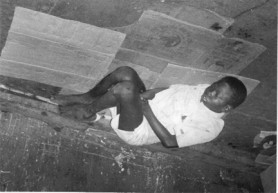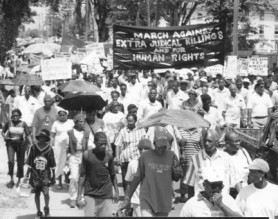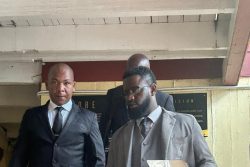By David A Granger
No month more than August evinces the patterns of challenge and response in the annals of the African-Guyanese experience. Most of all, it was on 1st August 1838 that African people regained their freedom after two centuries of enslavement in this land. It was on 3rd August 1834 that the Essequibo Revolt erupted at La Belle Alliance to protest the false freedom ordained by the Emancipation Act. It was on the bloody morning of 20th August 1823 that the British Army massacred over 200 persons at Bachelor’s Adventure on the East Coast during the Demerara Revolt. On that day, over 11,000 enslaved Africans from 55 plantations had attempted to march to Georgetown to demand their liberty.

Emancipation
The month of August, therefore, is a time of commemoration of the blood sacrifices of the men and women who struggled, suffered and were slaughtered to secure the freedom that the Guyanese nation enjoys today. It is also a time to celebrate the achievement of Emancipation. This event furnished the grounds for the indentured immigration of the Madeiran Portuguese, East Indians, Chinese and other West Africans and West Indians.
The rich demographic diversity, the economic transformation and the country’s cultural, social and political vitality all have their origins in African Emancipation. The newly-emancipated people were the founders the first villages which changed the cheerless landscape of cotton and sugar plantations into human habitations and farms. Guyanese of all races are their heirs.
The free people founded communities that were to become the crucible of African-Guyanese culture. They rested securely on the foundation of four pillars. The first was the establishment of farms and provision grounds which were essential to daily subsistence. These farms eventually made Guyana a major exporter of vegetables to the Eastern Caribbean by early in the 20th century. Second was the construction of personal homes in which the family could be consolidated. This was not possible in the communal yards of the plantation. Third was the construction of Christian churches and, finally was the erection of elementary schools. The founders’ purposefulness was exemplified in the passage of the Agreement made among the original proprietors of Victoria Village on 2nd May 1845 “…for the good regulation and general benefit” of the village. Among other things, they resolved:
…in gratitude to our Almighty Father to erect two buildings which shall be used and devoted to the purposes of religion as a School House and a Church where our children may be taught to read their Bibles and learn their several duties and where we may from time to time assemble and meet together and there offer up to Almighty God our humble prayers and thanks for the mercies we have received…

These enlightened ideas sprang from the minds of people who, a mere seven years earlier, had still been suffering under the system of enslavement ─ the worst crime against humanity in the history of the world. Emancipation was always understood to be not a finite event but the start of a continuous process in which the people continuously emancipate themselves. In the founders’ world view, the first principles of village life ─ consolidation of the family, acquisition of land, production and sale of commodities, adherence to the faith and construction of homes, schools and churches ─ were all part of self-liberation. These were the historical lessons of the Village Movement.
Emerging from the long night of enslavement, the founders realised that they could expect no charity from a vengeful planter class or sympathy from the Government. They understood that they had to work merely to survive. They had to be self-reliant and they were. It is a well-known fact that the first free villages came under challenge from the European planter class who sought to prevent the successful establishment of a free peasantry which could compete for land and labour.
Tradition
The early villages, despite their privations, were the womb of African-Guyanese society out of which a small class of educated, employed, enfranchised, property-owning citizens was born. Artisans, artists, attorneys, civil servants, journalists, musicians, nurses, postmasters, schoolmasters, servicemen, sailors, village chairmen and writers ─ all necessary to make a modern state function ─ eventually emerged from this inchoate class over the years.
The villages were not exclusive ethnic enclaves that locked out Amerindians, Chinese, Indians, Portuguese and persons of mixed ancestry. Within a century of Emancipation, almost every major African village had become multi-ethnic in population. Each could boast of a few university graduates or other distinguished daughters and sons. The first winner of the ‘Buxton Scholarship’ founded by the outstanding philanthropist Edmund Fitzgerald Fredericks, for example, was an Indian — Balbir Nehaul — who attended Queen’s College and became the first Guyana-born Government Bacteriologist and Pathologist. Africans, together with people of other ethnic groups, worked to build the nation now recognisable as Guyana.
Despite the success of some persons, however, many more remained mired in rural and urban poverty. The less successful were frequently subject to uninformed and unsympathetic abuse by non-Africans. Several derogatory stereotypes of the African character were published and many eloquent advocates repudiated those misrepresentations. John Sydney McArthur, KC, an eminent attorney-at-law, former Mayor of Georgetown and Member of the Court of Policy nearly a century ago, in his erudite essay — “Our People” — was able to show how the African people had been contributing to the country as fully as other ethnic groups.
Initiatives to mobilise the masses for self-improvement and to change the way they saw themselves were launched in the late years of the 19th and early years of the 20th century. James Mc Farlane Corry’s contribution to the establishment of the Co-operative Credit Banks was one of the most outstanding. Hubert Nathaniel Critchlow’s struggle for free labour unions permanently transformed industrial relations in the colonial economy. Edmund Fredericks’s philanthrophic work led to the establishment of a school of home economics for girls and an agricultural institute for boys.
Several organisations were established in the following years. Edmund Fredericks’s Negro Progress Convention; Dulcina Armstrong’s League of Coloured People; Hubert Nicholson’s African Society for Racial Equality; Eusi Kwayana’s African Society for Cultural Relations with Independent Africa; Joycelynne and Yvonne Loncke’s Pan African Movement (Guyana Branch) and Violet Jean-Baptiste’s African Cultural Development Association were among the best known. These were all examples of the efforts to change the lives of the common people up to the present day. The rise of mass-based political parties and Forbes Burnham’s struggle for national independence, together with these initiatives, helped to fufil the founders’ aspirations for Emancipation.
Transition
Distressing signs of disturbance became evident my mid-20th century. The traditional, cohesive, close-knit, folksy, village ‘community’ gradually went into decline. The causes were varied but were mainly due to demographic shifts. Upwardly-mobile villagers flocked to enlist in the South Caribbean Forces or to serve in other branches of the British Armed Forces during World War II. Many RAF veterans – among whom were Victor Crane, Cecil ‘Dusty’ Miller and Cleveland Hamilton – became prominent in the legal profession. Some sought work at the US Air Force Base at Atkinson Field, others migrated to study, work and live overseas.
The rise of city-based private secondary schools – such as Austin and Joseph Castello’s Tutorial High School and Modern High School, co-founded by JI Ramphal, M Beramsingh and Clement Yansen – provided unprecedented educational opportunities to thousands. Ambitious village youths were obliged to leave their homes to attend high school. These changes marked the transition from the ‘community’ to a more individualistic, self-centered ‘society.’ Traditional comity yielded to modernity.
Rural-urban migration was inevitable and evident everywhere. Qualified individuals tended to leave the villages to go to the towns or to migrate to the developed countries. Men of working age tended to travel in search of employment, occasionally leaving women, old folk and children behind. Some property-owners leased or sold their lands and never returned. These drained villages of potential leaders and impaired their capability for organisation and mobilisation.
Social, cultural, economic and technological changes also severely disrupted traditional lifeways. Transportation made access to the towns cheaper, easier and faster. Hand-made village products were undersold by more efficient, mass-produced manufactured imports. At the level of village culture, folklore and festivals yielded to movies and imported music. The secularisation of primary schools in the 1970s triggered a slippage in the standards of administration. Without fresh economic enterprise and investment, buildings, roads and other infrastructure fell into disrepair even as residents demanded more efficient utilities and services — electricity, water, telephone and transport. The political revolution of the 1950s not only energised but also polarised the once easy-going electorate, turning loyalties from community to party. The ‘Disturbances’ of the 1960s, more than any other event, disrupted the complaisant inter-ethnic relations and ruptured community solidarity. The first street children became evident in the towns in the 1970s. Unemployment, accompanied by the narcotics trade and violent crime surged in the 1980s as parents turned to street vending and migration. Grave public safety and public health crises loomed in the 1990s: police killings soared with 4 out of every 5 victims being African-Guyanese and the HIV-AIDS epidemic took away bread-winners. The ‘Troubles’ on the East Coast – the most frightening wave of criminal violence in the country’s history – broke out in the 2000s as narcotics-trafficking and gun-running surged. Drug gangs and death squads killed an uncounted number of innocent persons.
Waking the dead
The majority of Guyanese people have always been poor. In the distant past, however, even the poor could hope to improve their living conditions and enjoy a high quality of life through a virtuous circle of education-employment-enterprise-empowerment. It is now evident that many have been ensnared in economic misery and poverty. Destitute members of this the growing underclass seem to be crawling out of every alley and avenue.
Problems persist away from the streets. Semi-literate, semi-disciplined adolescent pupils drop out of schools to start uncertain careers as adults. Unemployment and underemployment have had the effects of poor education, poor nutrition, poor health and poor housing on children. Delinquent youths too easily become victims of the vicious cycle of unemployment-poverty-crime-imprisonment-unemployment.
Clarence Ellis, writing in the Emanci-pation magazine in 2003, pointed to the need for an African-Guyanese agenda. His ‘Agenda’ raised questions about identity, the economy, employment, empowerment and other issues affecting Africans in Guyana. Ellis’s initiative rejected the easy resort to soliciting handouts from the Government or seeking solutions from the politicians — approaches which have been proven to be bankrupt over the past 50 years.
Emancipation means self-liberation. Education makes people free from ignorance. Employment makes them free from dependence. Empowerment makes them free from domination and marginalisation. The challenges facing the African-Guyanese people today are not fundamentally different from those that their ancestors faced in the post-enslavement era.
Yet, the present generation knows more about the Emancipation Movement than those who were involved in it because its consequences are evident today. This knowledge of the past is the key to the renewal of the present. Those who try to erase whatever they find inconvenient from the historical record run the risk of effacing future prospects as well.
Guyanese today – one hundred and seventy-two years after Emancipation – seem to be oblivious of the aspirations and accomplishments of their ancestors. They would do well to recapture the spirit that once inspired those hardy founders to transform a string of plantations into a nation.




